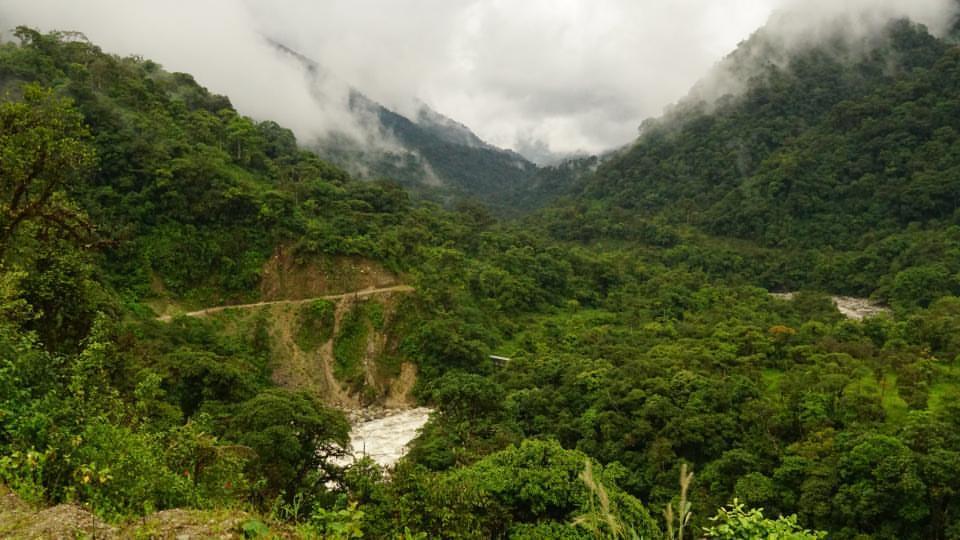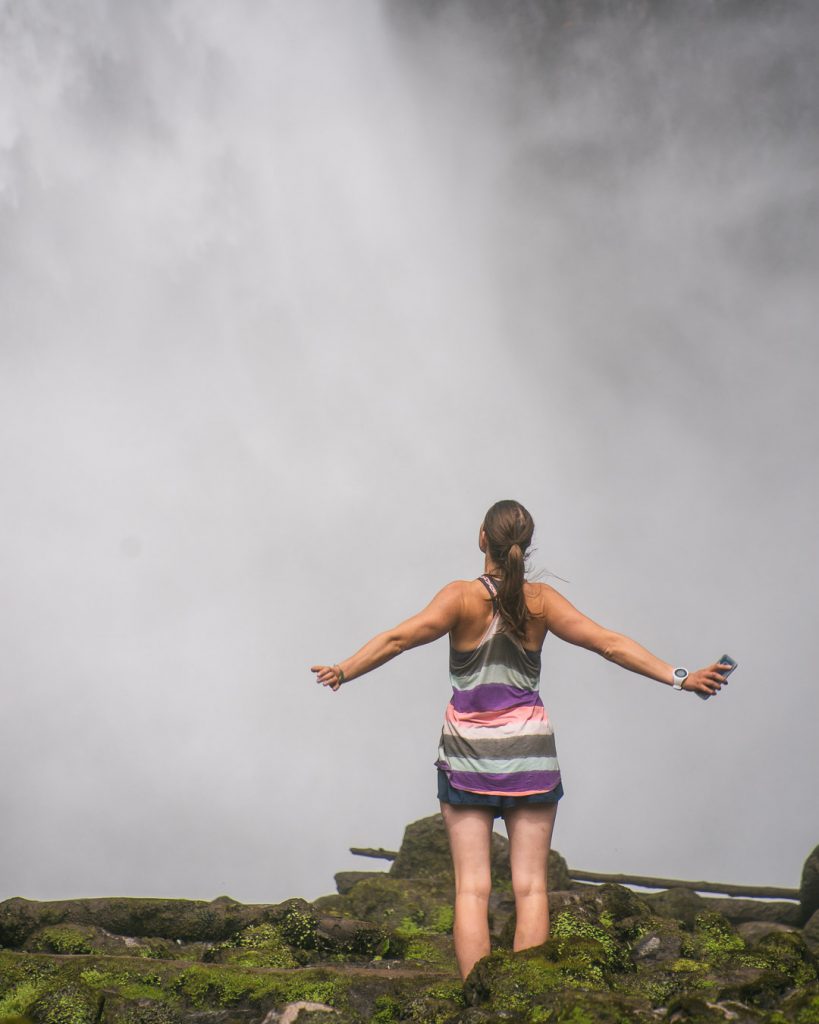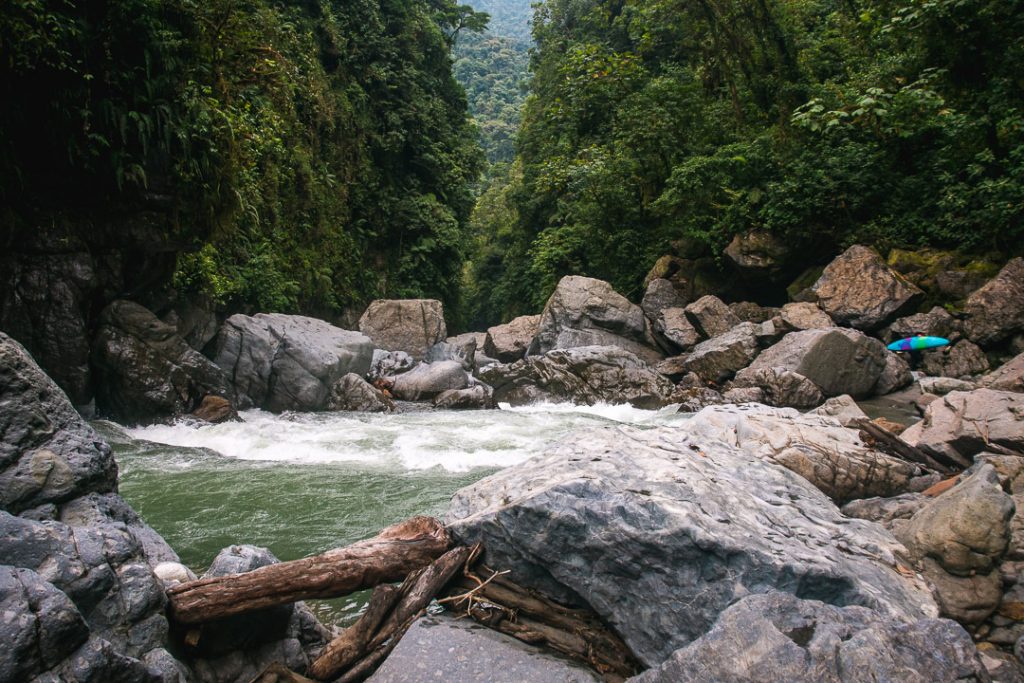The Rio Cofanes is the unicorn river in Ecuador. On the walls of Gina’s restaurant are two big portraits of beautiful bedrock canyons, contrasting the pink and grey walls with the luscious green of the jungle above. Of all the photos on display, they are the ones that your eyes are drawn to, filling you with wonder and desire.
The Rio Cofanes is in the north of Ecuador, near the border with Columbia. Putting on in the quaint mountain village of La Sofia, the river winds down for 34 miles until it confluences with the Rio Chingual to form the Aguarico (meaning “rich water” – presumably due to the discovery of gold). Starting out at a gradient of 105 feet per mile, the river cuts its way through three beautiful bedrock canyons. A third of the way into the run, the Rio El Dorado joins, the gradient halves and the river becomes more open. But more importantly than the guidebook facts – the river looks like a dream.

So, what’s the catch?
The Cofanes is notoriously hard to catch at the right levels. It has to be low. The three bedrock canyons are completely committing, filled with must-run rapids and a pretty sketchy portage. Once you are in, there is only one way out – downstream. Now, remember that you are in a rainforest with no reliable weather forecast to speak of. So, it is not surprising to learn that only 9 crews have ever previously descended the river. There had been a lot of rain in Ecuador this season, so I never thought this would be the year. However, after a week-long dry spell, we got the call that we had been hoping for! Knowing that this was not a river to run as a pair, Jeremy Nash and myself spent the next hour trying to convince Rowan James (who was fresh off the plane 12 hours earlier) and Jack Grace (who had never done a multiday before) that this river would be everything that was missing from their lives.
After a 6-hour drive to the put-in the next day, with a quick pit stop to buy food and a machete and the opportunity to be real tourists at the Magico waterfall, we were greeted with primo flows. Filled with anticipation and excitement, we explored the local village, chased some chickens, tried to befriend a parrot, and put some important phone numbers into my InReach.

📷: Jack Grace
Just as it started to get dark, the heavens opened and the rain poured down upon us. Nervously looking around at each other, no-one wanted to voice aloud our concerns. “It’s the best river of your life” – Abe Herrera’s words echoed around my head as I kept all of my fingers and toes crossed for it to stop raining. After the longest hour of my life, it started to subside. However, my night’s sleep was still restless, filled with dreams of flash floods and portaging mishaps. Thankfully, I woke up to find the stars shining down upon us! The next day we tried our best to force the big breakfast of rice, lentils, chips, and chicken down our throats at 6am to give ourselves enough energy for what lay ahead. We packed up quickly and hiked down the steep road to the put-in. A big sigh of relief echoed around as we saw that the river was still crystal blue and did not appear to have risen significantly from the night before.
Right from the get-go, the action started, with high-quality rapids weaving their way through a maze of big boulders. Jeremy took the lead, as the driving force for the trip, with no rapid too steep for him to read and run. Countless boofs and waves had us grinning from ear to ear as the reality that we had actually made it to the Cofanes began to sink in. The first canyon passed without much difficulty and the whitewater eased for a second, giving us the opportunity to take in our surroundings and check our progress on the map.
Reaching the second canyon, we were greeted with a large horizon line dropping into the steep-sided gorge. I knew this was the “Narnia” rapid from the photo at Gina’s. Hopping out to scout, the rapid was steeper and burlier than I had been expecting. At the bottom of the rapid, all the water dropped away into what looked like a giant hole, with the water flushing out of the right side quickly towards… the canyon wall? We were unable to see past the corner to be 100% sure, but at least we could take comfort in the giant pool we could see downstream.
Jeremy’s last words of wisdom were to remember my new year’s resolution (to have more confidence in my kayaking) and that he would be at the bottom. Then he jumped in his boat and paddled into the abyss. I quickly followed suit, knowing that scouting for longer would only serve to make me more nervous. Whilst driving right for the final move, I got caught in the seam, plugged off the drop, went straight down to Narnia, and popped up the other side, feeling very happy and relieved!
Miles of quality read and run whitewater in the third canyon eventually led us to the portage. This was the part that I was dreading. A couple of years ago the perfect waterfall boof on the Cofanes collapsed, leaving behind a walled-in hole which is unrunnable except at the lowest flows. The only way around is to jump from one slippery-as-ice boulder to another, lower boats down, then try to find a spot on the rock flat and stable enough to get in your boat. Oh, and this all happens right above a siphon. Figuring out the best way to tackle the portage was like a fun puzzle, but actually doing it was one of the scariest things I’ve done in a while! It was great to be with a team who I completely trusted to work together and keep each other safe, but I was very glad to see the back of it once it was over.

📷: Jack Grace
Cruising on down knowing the worst was done, we passed the confluence with the Rio El Dorado. At this point the flow doubled, the river opened up, and the character changed. All that was left to do was to find the perfect spot to hang our hammocks, make some dinner, and get a well-earned night’s sleep! The next day, with all of the hard work behind us, we could sit back and enjoy the stunning scenery. Thin veils of water shimmered down the cliff walls whilst parrots screeched in the sky, flying back and forth above our heads.
The kayaking was much faster on the second day. Even though we still had half the distance to cover, we reached the takeout only 3 hours after putting on. We lucked out when we found a group of local fishermen, with their truck parked right at the takeout, who agreed to drive us to Lumbaqui so that we could catch a bus back to Baeza. Exhausted and aching but elated, we even arrived back in time for the Bridge to Bridge race party.
The Cofanes really was everything I had hoped for and more. It was some of the best read-and-run whitewater I have ever done, in one of the most remote, beautiful places I have ever been to. Our need to get past the portage on the first day prevented us from taking much media, but this is a trip that I will not forget anytime soon!



